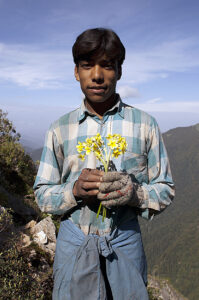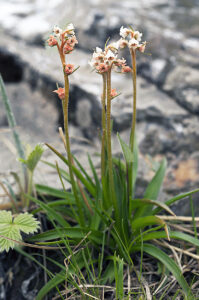Kaj Halberg - writer & photographer
Travels ‐ Landscapes ‐ Wildlife ‐ People
Abode of the deodar
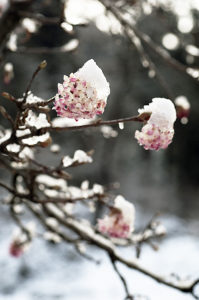
From time immemorial, the local inhabitants of this area have been utilizing it, hunting, collecting wild plants for food and medicine, grazing cattle and goats, and collecting timber and firewood. Today, this traditional usage is no longer allowed. The Indian Forest Department, together with several NGO’s, makes an effort to help the local people by offering some to work as park rangers, and others as guides and porters for visiting tourists.
Several timber plantations have been established, and likewise nurseries for plant species, which have traditionally been collected for folk medicine or other usage, including West Himalayan yew (Taxus contorta) and a composite, Jurinea depressa, locally called dhup. Through these initiatives, the authorities hope that the locals will respect the park regulations.
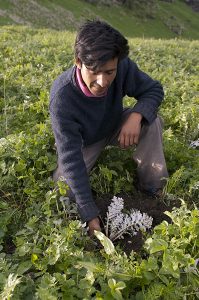
Following the termination of livestock grazing in the area around 1990, the locals no longer maintained the trails, and when our hikes took place, the trails had simply vanished in many places, making our hike rather hair-raising at times. We had to negotiate temporary ’bridges’, jump from one rock to another, climb down vertical rocks, and walk along narrow and slippery trails, full of fallen oak leaves.
On one occasion, at the outskirts of the park, we had to follow a cattle track, overgrown by herbs up to a height of 2 m or more, which blocked our view, causing us to slide along in greasy cow pats. I was somewhat comforted by the fact that my guide and porters slid and fell as often as I did in this slush.
Most of the plant species mentioned below are dealt with in detail on the pages Plants: Himalayan flora 1, 2, and 3.
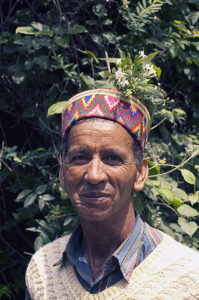

Herbs on the forest floor included giant Himalayan lily (Cardiocrinum giganteum), which grows to 2 m tall, a columbine, Aquilegia pubiflora, and Geum roylei, which very much resembles the European common avens (Geum urbanum). Along the trail, we observed many species, including various knotweeds (Bistorta, Persicaria, Koenigia), a pale-blue larkspur, Delphinium denudatum, an orange wallflower, Erysimum benthamii, and a beautiful iris, Iris milesii, with long, scimitar-shaped leaves.
In clearings, including former fields, bushes of the rose family were ubiquitous, such as Spiraea canescens, Sorbaria tomentosa, and Rubus niveus, also known as R. foliolosus, as well as a climber, Cynanchum auriculatum, of the periwinkle family (Apocynaceae).
Common pokeweed (Phytolacca acinosa) was also quite common. The inflorescence of this species is up to 15 cm long, its yellowish-white flowers later developing into black berries. These berries are not edible, but the leaves make an excellent vegetable – but only after being boiled twice.
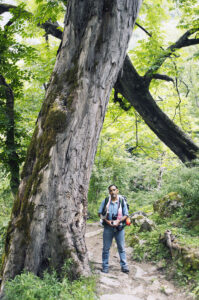

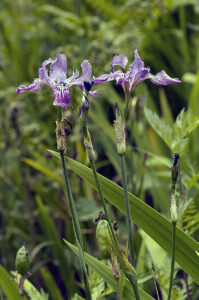
We often found oak leaves with a large, round hole in the centre, made by the white-bellied giant flying squirrel (Petaurista albiventer), which folds the leaf along the mid-rib, whereupon it eats the central part, avoiding the edge of the leaf, which is more toxic than the centre.
At a slightly higher altitude, various conifers became dominant, especially Himalayan cedar, or deodar (Cedrus deodara), Himalayan spruce, and blue pine (Pinus wallichiana). This park constitutes one of the core areas of the Himalayan cedar, which is otherwise distributed from Afghanistan to western Nepal. This tree can grow to enormous dimensions, up to 80 m tall, its huge bole having a circumference of up to 12 m. Its generic name, Cedrus, from the Greek kedros, stems from an ancient Indo-European word, meaning incense. Formerly, needles and wood of cedar were used as incense, like various species of juniper and cypress. Today, traditional medicine is made from an essential oil in its wood.
Himalayan spruce is distributed from Afghanistan eastwards to central Nepal, while blue pine is very common in a huge area between Afghanistan and south-western China. Blue pine can be identified by its bluish foliage and huge cones, which grow to 25 cm long. A picture of its cone is shown on the page Plant hunting in the Himalaya: Around the sacred lakes of Shiva.
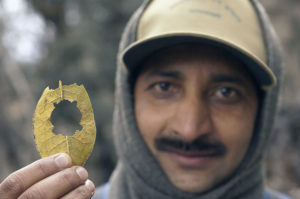
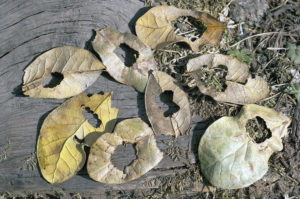
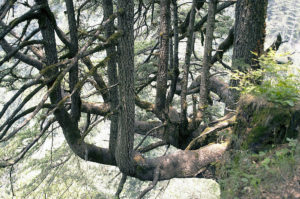
On the steepest slopes, few trees were growing, and large areas were covered in a pink-flowered shrub, Indigofera heterantha, of the pea family (Fabaceae). In the Himalaya, no less than 16 members of this genus are found. Formerly, a blue dye, indigo, was extracted from a lowland species, Indigofera tinctoria, but nowadays the dye is produced synthetically. Incidentally, indigo cannot be extracted from any of the Himalayan species. Here and there, two rose species were encountered, a shrub with pretty pink flowers, Rosa macrophylla, and a climber with white flowers, Rosa brunonii.
During our spring hike, various herbs were encountered on rock walls in the forest, including a large, white-flowered windflower, Anemone tetrasepala, which was very common, a pink rock-jasmine, Androsace sarmentosa, the handsome Himalayan alpine bells (Primula matthioli ssp. brotheri), and the white-flowered Acanthophyllum cerastioides, formerly known as Gypsophila cerastioides, a member of the carnation family (Caryophyllaceae). A pretty bellflower, Campanula argyrotricha, was observed during our autumn hike, growing on a vertical rock wall.
In this zone, herbs grew sparsely on the forest floor, although we did find several species, including Geranium himalayense, which very much resembles the European meadow cranesbill (G. pratense), but is larger. We also encountered a plant with tripartite leaves, Trillium govanianum, which is related to the European Herb Paris (Paris quadrifolia). Lately, both of these species have been moved from the lily family (Liliaceae) to the trillium family (Melanthiaceae). Other species included a large-flowered aster, Aster thomsonii, a Solomon’s seal, Maianthemum purpureum, the tiny Himalayan wulfenia (Wulfeniopsis amherstiana) of the plantain family (Plantaginaceae), and two beautiful ground-living orchids, a white lady’s slipper, Cypripedium cordigera, and Calanthe tricarinata.
Large areas of the forest floor had been dug over by bears, of which two species are found in the national park. The Asian black bear (Ursus thibetanus) is mostly encountered in forests of lower altitudes, whereas a subspecies of the brown bear, the isabelline bear (Ursus arctos ssp. isabellinus), mainly lives in areas above the tree line, occasionally entering the forest.
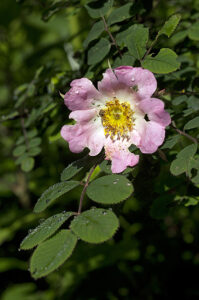
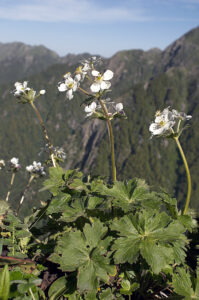
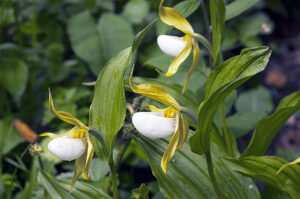
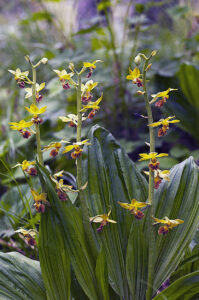
In these temperate forests live no less than five species of pheasant. Gorgeous cocks and brown-speckled hens of monal (Lophophorus impejanus) often took to the wings in front of us, gliding several hundred metres down into the valley, cackling loudly. This species is very common in the park. Koklas pheasant (Pucrasia macrolopha) and kalij pheasant (Lophura leucomelanos) are less numerous, whereas chir pheasant (Catreus wallichi) and western tragopan (Tragopan melanocephalus) are very rare, the latter being globally threatened. The Great Himalayan National Park, however, constitutes one of its core areas.
Several clearings in the forest indicated that grazing had formerly taken place here. Since this grazing was banned, the vegetation in these clearings has changed dramatically. Previously, most plants were either toxic or prickly, or they were able to withstand intense grazing. Nowadays, the vegetation is dominated by tall herbs, such as various species of knotweed, dock, or nettle, which has taken over large areas.
However, several other species can still be seen in clearings, including a large, blue-flowered stickseed, Hackelia uncinatum, a white windflower, Anemone rivularis, a wild buckwheat, Fagopyrum dibotrys, and a cinquefoil, Potentilla argyrophylla, which exhibits a tremendous variety of flower colours, from yellow via orange to red and purplish.
The handsome Morina longifolia is also conspicuous in clearings. Formerly, Morina species were included in the scabious family (Dipsacaceae) but were then transferred to a separate family, Morinaceae. However, recent genetic research has reduced these two families to a subfamily, Dipsacoideae, within the honeysuckle family (Caprifoliaceae). Four species occur in the Himalaya, all furnished with stiff hairs or spines as a means of defence against grazing animals. The genus was named in honour of French physician, botanist, and meteorologist Louis Morin de Saint-Victor (1635-1715).

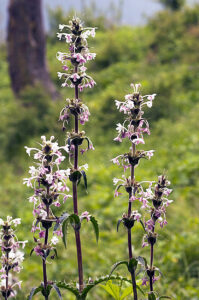
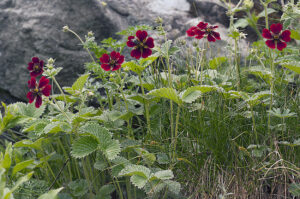
Herbal vegetation in these meadows is indeed rich, the majority blooming during the monsoon. In June, when our spring hike took place, precipitation is moderate, but nevertheless we found many flowering species. Of these, the majority were also encountered in the forest, but some were restricted to these meadows. Common species included alpine forget-me-not (Myosotis alpestris), a species of avens with large, yellow (rarely red) flowers, Geum elatum, a violet lampwick plant, Phlomoides bracteosa, and a windflower, Anemone obtusiloba, which in this area comes in two colour forms, white and blue. A third variety with yellow flowers is restricted to Kashmir. Banks along the streams were covered in thousands of Himalayan marsh-marigolds (Caltha palustris).
A number of interesting plants were encountered here. Two species were abundant, an alp lily, Gagea longiscapa (formerly called Lloydia longiscapa), and the tiny, but handsome Aletris pauciflora, which has been moved from the lily family (Liliaceae) to the family Nartheciaceae.
A beautiful poppy, Meconopsis aculeata, brightened the landscape with its large, pale-blue flowers. 17 species of this spectacular genus are found in the Himalaya, the major part from Nepal eastwards. We also found the strange black hellebore (Picrorhiza kurrooa), of the plantain family (Plantaginaceae), with 3-cm-long stamens projecting from its tiny flowers. This plant, which is utilized as traditional medicine, is threatened by excessive collecting.
Other species included Dactylorhiza hatagirea, which resembles the European early marsh orchid (D. incarnata), a cushion-forming rock-jasmine, Androsace muscoidea, and two tall primroses, Primula stuartii with pale yellow flowers and P. macrophylla with violet flowers.
Animal life is sparse at these altitudes. During our autumn hike we observed large flocks of snow pigeons (Columba leuconota), and during our spring hike, a lammergeier (Gypaetus barbatus) was soaring along a ridge on the lookout for carcasses, while a red fox (Vulpes vulpes ssp. montana), with pale parts here and there on its coat, watched us with interest, before trudging along. In the foggy weather, we surprised two young brown bears, which were busy digging for roots, only about 50 m away. Spotting us, they snorted and ran for dear life.
